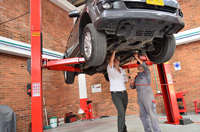 You saved money in your 401(k), and you want to use it. Your age, employment status and 401(k) account rules factor into how you can take money out of your 401(k) account, though. Know the rules so that you can avoid expensive penalties while accessing the funds you have saved.
You saved money in your 401(k), and you want to use it. Your age, employment status and 401(k) account rules factor into how you can take money out of your 401(k) account, though. Know the rules so that you can avoid expensive penalties while accessing the funds you have saved.
When You Are Still Employed by the Sponsoring Company
As long as you’re still employed by the company that sponsored your 401(k), you can take the funds out for three different purposes. Remember that you will be charged interest, and you will have to repay the loan or withdrawal.
- 401(k) loans allow you to borrow from your account balance to pay almost any expense. Usually, there’s a limit of $50,000 or half of your vested 401(k) balance.
- 401(k) hardship withdrawals allow you to use money in your account for certain expenses. Buy a home or prevent eviction, pay medical expenses, cover higher education costs or relieve severe financial pressure.
- 401(k) in-service distribution allows you to take a portion of your vested balance from your account. You must be over 50-1/2 years old and invest the funds into a qualified retirement account if you use this option to gain greater control over your saved funds.
When You’re No Longer Employed at the Sponsoring Company
After you leave the company that sponsored your 401(k), you may access your funds by contacting the plan administrator. The funds are no longer available for you to borrow, but you can withdraw the money and spend, save or roll it into a new retirement account.
- A regular withdraw applies if you are over the age of 59-1/2 years. You will pay income tax on the money you withdraw, but there are no penalties. Use the distributions for living expenses or save them for the future.
- Early distributions apply to 401(k) funds you withdraw before you’re 59-1/2 years old. You will pay taxes on the money you withdraw and a 10 percent penalty.
- Roll over your 401(k) into an IRA. You pay no taxes on the funds, and your money continues to accumulate interest.
When You Are the Beneficiary of a 401(k) Plan
As the beneficiary of a 401(k) plan, you may access the money under certain conditions. The distributions depend on the plan participant’s age and whether or not you’re the spouse of the 401(k) participant.
Your 401(k) is a tool that helps you save for retirement. While you can access the funds, be sure to understand any penalties and tax consequences first. For more information, talk to your 401(k) plan administrator or financial advisor.














